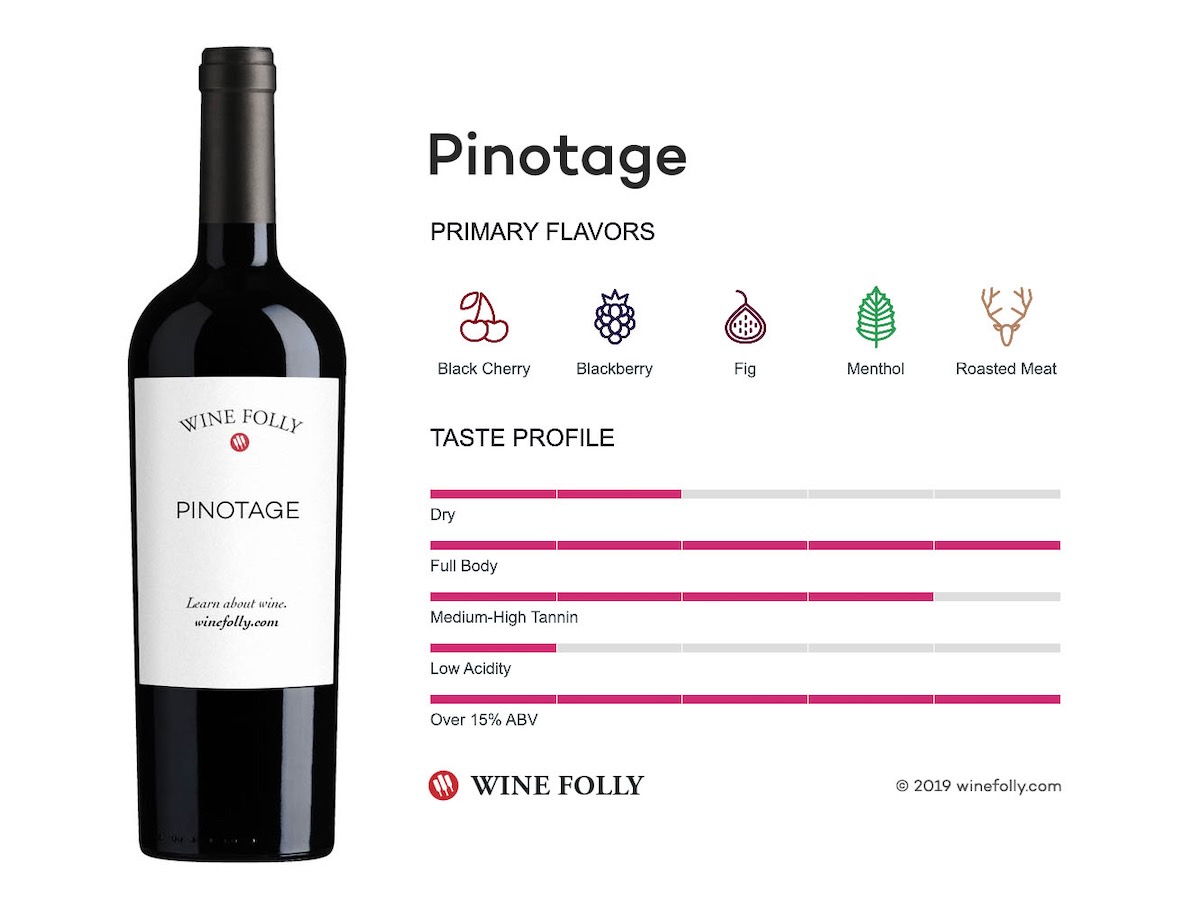I know, I know — you’ve had bad Pinotage before. Or maybe you haven’t. But Pinotage has a bad reputation among many for its, shall we say, unique tasting notes. Perhaps the smell reminded you of black cherries with a heavy helping of burned rubber. Maybe nail polish remover came to mind as you contemplated the sensations on your palate. Whatever the case, you were (rightfully) unimpressed.
What is Pinotage?
This oft-maligned grape is a cross of Pinot Noir and Cinsault, then called Hermitage in the Cape (hence the name “Pinotage).” Professor Abraham Perold created in South Africa in the mid-1920s. Cinsault was widely planted in South Africa’s winelands due to its heat and drought tolerance, and Perold was tasked with bringing better French cuttings of Pinot Noir into the country. The first plantings were eventually rescued from Professor Perold’s garden, and the first commercial Pinotage on the South African market appeared in 1961 under the Lanzerac brand.

The above graphic from Wine Folly introduces some of the qualities of Pinotage.
In the world of wine grapes, Pinotage is practically an infant compared to other varieties that have been around for hundreds or even thousands of years. While early attempts at vinifying the grape often led to questionable results, we now know a lot more about the grape and how it behaves in the century since its creation.
But don’t blame the grape. Winemakers across South Africa have unlocked its potential in delicious and surprising ways. Pinotage iis rightfully getting a second chance, and vintners nationwide have figured out how to harness its power — or even showcase its lighter, restrained side.
A Fast Fermenter
One of the oddities of Pinotage is its lighting-quick fermentation time. If you were to harvest, crush, and begin fermentation of, say, Cabernet Sauvignon and Pinotage under all of the same conditions, the Pinotage would complete fermentation in roughly half of the time it would take the Cabernet. Pinotage can ferment to dryness in a mere 3 to 4 days.
Its high nitrogen content is in part responsible for this, and earlier attempts to make Pinotage failed to take this into account. The relatively formulaic winemaking techniques applied to varieties like Syrah or Merlot were, unfortunately, also applied to Pinotage, and these longer fermentations allowed for the extraction of the harsh, unpleasant notes so many have come to associate with the grape.
Early Harvest Gets the Goods
Pinotage has a propensity to reach very high sugar levels when summer heat spikes occur across South African growing regions. This can result in Pinotage that’s high in alcohol and feels, at times, a little flabby on the palate due to low acidity levels.
But a look toward Pinotage’s parent grapes, Pinot Noir and Cinsault, allows for a reframing of its abilities. Though historically vinified in a style to match big, bold reds from other New World markets, producers like David & Nadia in the Swartland have tapped into the more subtle, leaner side of the grape.
The trick? Early harvesting before mid-summer temperatures top the scales. Pinotage is an early-ripening variety, and David & Nadia harvest their Pinotage in mid-January. This is before they bring in any of the white grapes they vinify. This, coupled with gentle extraction techniques, results in a wine akin to a Beaujolais Cru with plenty of red berry fruit, the earth and spice you expect from Pinotage, and delightfully modest alcohol levels.
Stay Cool, Bro: Pinotage’s Growth in a Unique Climate
But perhaps one of the greatest changes when it comes to Pinotage in the Cape comes down to where winemakers are now planting it.
For the greater part of the 20th Century, legislation dictated much about where one could plant and grow grapes, which incentivized farmers to prioritize quantity over quality, often in the warmer districts of the Cape. But with the end of Apartheid, newer, cooler pockets of the country suddenly opened up. It’s here that Pinotage seems to have found a home (free of heat spikes for the most part, too).
Winemakers like Emul Ross of Southern Right and Ashbourne (as well as Pinot & Chardonnay titan Hamilton Russell Vineyards) are crafting more restrained, leaner iterations of the cultivar in the Hemel-en-Aarde Valley and Walker Bay in the Cape South Coast.
In these wines, you’ll find plenty of dark berry fruit to go around — think black cherry and mulberry — accompanied by breezy smoke and spice with just enough of a tannic tug to keep it structured. They’re practically begging for barbecue.
The Final Word: So…Could Pinotage Be Good?
Despite all of these developments and advances, you’ll still find some Pinotages that might remind you of, say, an actual tire fire, or perhaps nail polish-coated bananas gently roasting over ashy embers. But so many of the negative traits we associate with Pinotage have a lot more to do with winemaking than the variety itself.
My friends, it’s time to give this BBQ-friendly grape another look. We’re just about to celebrate the variety’s 100th birthday, but I think we’re only getting started.
Story by Adam Knoerzer
Subscribe to TABLE Magazine‘s print edition.

